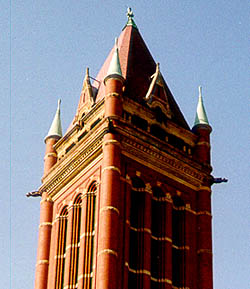
Allegany County is a county located in the northwestern part of the U.S. state of Maryland. As of the 2020 census, the population was 68,106. Its county seat is Cumberland. The name Allegany may come from a local Lenape word, welhik hane or oolikhanna, which means 'best flowing river of the hills' or 'beautiful stream'. A number of counties and a river in the Appalachian region of the U.S. are named Allegany, Allegheny, or Alleghany. Allegany County is part of the Cumberland metropolitan area. It is a part of the Western Maryland "panhandle".

Frostburg is a city in Allegany County, Maryland. It is located at the head of the Georges Creek Valley, 8 miles (13 km) west of Cumberland. The town is one of the first cities on the "National Road", US 40, and the western terminus of the Western Maryland Scenic Railroad. It is part of the Cumberland metropolitan area.

The Shaw Mansion is an Italianate style house in the George's Creek Valley of Allegany County, Maryland, built in 1872. The house is significant as an unusually large and well-preserved example of the style for its area, with stone trim, detailed brick bonding, cast-iron mantels and much of the original interior woodwork.

16 Altamont Terrace is a historic home in Cumberland, Allegany County, Maryland, United States. Built circa 1851, it is an example of Greek Revival architecture, with an Ionic portico above a stone foundation and cast iron balconies. The house served as the Allegany County hospital from 1889 to 1890. The building was converted into apartments in about 1905.
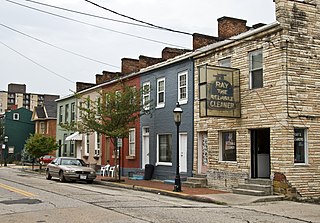
200, 202, 204, 206 and 208 Decatur Street are adjoining rowhouses in Cumberland, Allegany County, Maryland. The houses were built in the 1840s or early 1850s. The houses are of a type that, while common elsewhere in Maryland, were not extensively built in Cumberland, in which individual and semi-detached houses were more common. The houses exhibit plain but consistent detailing of a neoclassical nature.

Big Bottom Farm is a farm in Allegany County, Maryland, United States, on the National Register of Historic Places. The Greek Revival house was built circa 1845, possibly by John Jacob Smouse, and exhibits a level of historically accurate detailing unusual for the area. The property includes a late 19th-century barn and several frame outbuildings.
The Borden Mines Superintendent's House was built in 1850 in Frostburg, Allegany County, Maryland. The Italianate style villa was built for Albert C. Green, first superintendent of the Borden Mining Company, one of the oldest mining companies in the United States. The frame house, with its three-story tower was one of the first of this style to appear in Allegany County.
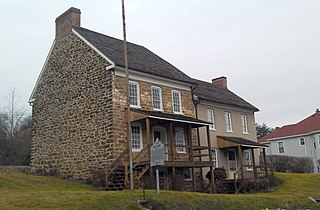
Michael Cresap House is a historic home in Oldtown, Allegany County, Maryland, USA. It is a 2+1⁄2-story, two-part stone and brick house built about 1764. The house is associated with Captain Michael Cresap (1742–1775), a well known Ohio frontiersman.

Thomas Koon House is a historic home in Cumberland, Allegany County, Maryland, United States. It is a brick Prairie-style house of large scale built in about 1912. It features arranged rectangular blocks with large expanses of window space, a terra cotta tiled hip roof and a small similarly influenced detached garage. The house was designed by Holmboe & Lafferty of Clarksburg for Doctor Thomas W. Koon, who arrived in Cumberland setting up an "active general practice" in May 1900.

George Truog House is a historic home in Cumberland, Allegany County, Maryland, United States. It is a 3-story brick structure built in 1903. The house was designed by local architect Wright Butler, and built by George Truog, proprietor of the Maryland Glass Etching Works in Cumberland from 1893 to 1911. It contains a unique collection of decorative glass.

Wright Butler House is a historic home in Cumberland, Allegany County, Maryland, United States. It is a 2+1⁄2-story, Queen Anne-style suburban one-unit dwelling built about 1896. The house was the home of Wright Butler (1868–1932), one of Cumberland's leading architects at the turn of the 20th century. He also designed the George Truog House.
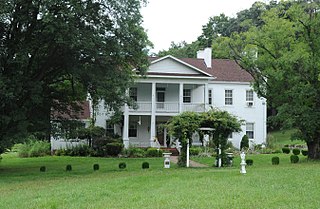
Phoenix Mill Farm, historically known as Mill Run Farm, is a historic home located in Dickens, Allegany County, Maryland, United States. It is a 2+1⁄2-story Flemish bond brick structure showing Greek Revival style influences built about 1845. It has a gable roof and double flush chimneys. On the property is the site of Smouse Mill. The home was erected for John Jacob Smouse, who operated the mill.
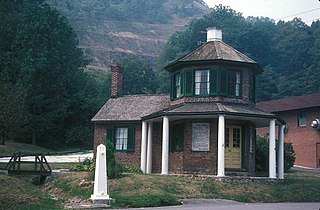
La Vale Tollgate House is a historic toll house in La Vale, Allegany County, Maryland, United States. It is a two-story brick structure built in 1835–1836, with seven sides—a basic polygon plan. A one-story Tuscan-columned porch extends around the five outer sides of the polygonal portion. On top is a non-functional reconstructed cupola. The building served as a toll house on the Cumberland or National Road and was the first such structure to be erected.
The Shawnee Old Fields Village Site, is an archaeological site near Oldtown in Allegany County, Maryland. The site contains Late Woodland and Contact period artifacts. An area between the site and the river's edge may be the location of a number of short-term camps and/or dwelling units. The first confirmed archeological manifestation of the several historically documented Shawnee villages in Maryland. It is believed to have been the home of Chief Opessa Straight Tail, a Shawnee leader.
The Frostburg Historic District is a national historic district in Frostburg, Allegany County, Maryland. It comprises 356 resources within the city of Frostburg, along U.S. Route 40, which forms the main axis of the district. Included are a collection of early-20th century commercial buildings, primarily of brick construction, two or three stories tall, and a collection of mid- to late-19th and early-20th century homes reflecting a variety of architectural styles, including Italianate, Second Empire, Queen Anne, and Colonial Revival.

The Washington Street Historic District is a national historic district named after George Washington in Cumberland, Allegany County, Maryland. It is an approximately 35-acre (140,000 m2) residential area to the west of downtown Cumberland and consists primarily of six blocks of Washington Street. It contains large-scale 19th- and 20th-century houses representing most of the major architectural styles, including examples of Greek Revival, Italianate, Gothic, Queen Anne, Romanesque, Colonial Revival, and bungalow. Also included in the district are the 1890s Romanesque courthouse, the 1850s Greek Revival academy building, and the Algonquin Hotel. It was listed on the National Register of Historic Places in 1973.

The Inns on the National Road is a national historic district near Cumberland, Allegany County, Maryland. It originally consisted of 11 Maryland inns on the National Road and located in Allegany and Garrett counties. Those that remain stand as the physical remains of the almost-legendary hospitality offered on this well-traveled route to the west.

Mt. Pleasant, also known as the Clemson Family Farm, is a historic home located at Union Bridge, Carroll County, Maryland, United States. It is a five-bay by two-bay, 2+1⁄2-story brick structure with a gable roof and built about 1815. Also on the property is a brick wash house, a hewn mortised-and-tenoned-and-pegged timber-braced frame wagon shed flanked by corn cribs, and various other sheds and outbuildings. It was the home farm of the Farquhar family, prominent Quakers of Scotch-Irish descent who were primarily responsible for the establishment of the Pipe Creek Settlement.

Lonaconing Furnace, also known as The George's Creek Coal and Iron Company Furnace No. 1, is a historic iron furnace in Lonaconing, Allegany County, Maryland, United States. It is a truncated square pyramid constructed of sandstone, 50 feet (15 m) high, 50 feet square at the base, and 25 feet square at the top. It first produced iron in 1839, then the iron operation was abandoned in the mid-1850s, the Loncaconing Furnace complex included a top house, molding house, engine house, and two hot-air furnaces for heating the blast. None of these ancillary structures remains. It played a significant role in demonstrating that both coke and raw bituminous coal could be used as fuels in the manufacture of iron. It is known as "the first coke furnace, whose operation was successful, erected in this country."

Klots Throwing Company Mill is a historic silk mill located at Cumberland in Allegany County, Maryland, United States. It was built in 1902–1903, and is a long two-story brick building with double-gable roofs and paired stepped parapets. An addition was built in 1909. It was operated by Gentex Corporation and closed in 1972. The building was subsequently used for storage. From 1988 until 2002, the north end of the building housed the Western Maryland Food Bank. The building will be converted to loft apartments.





















